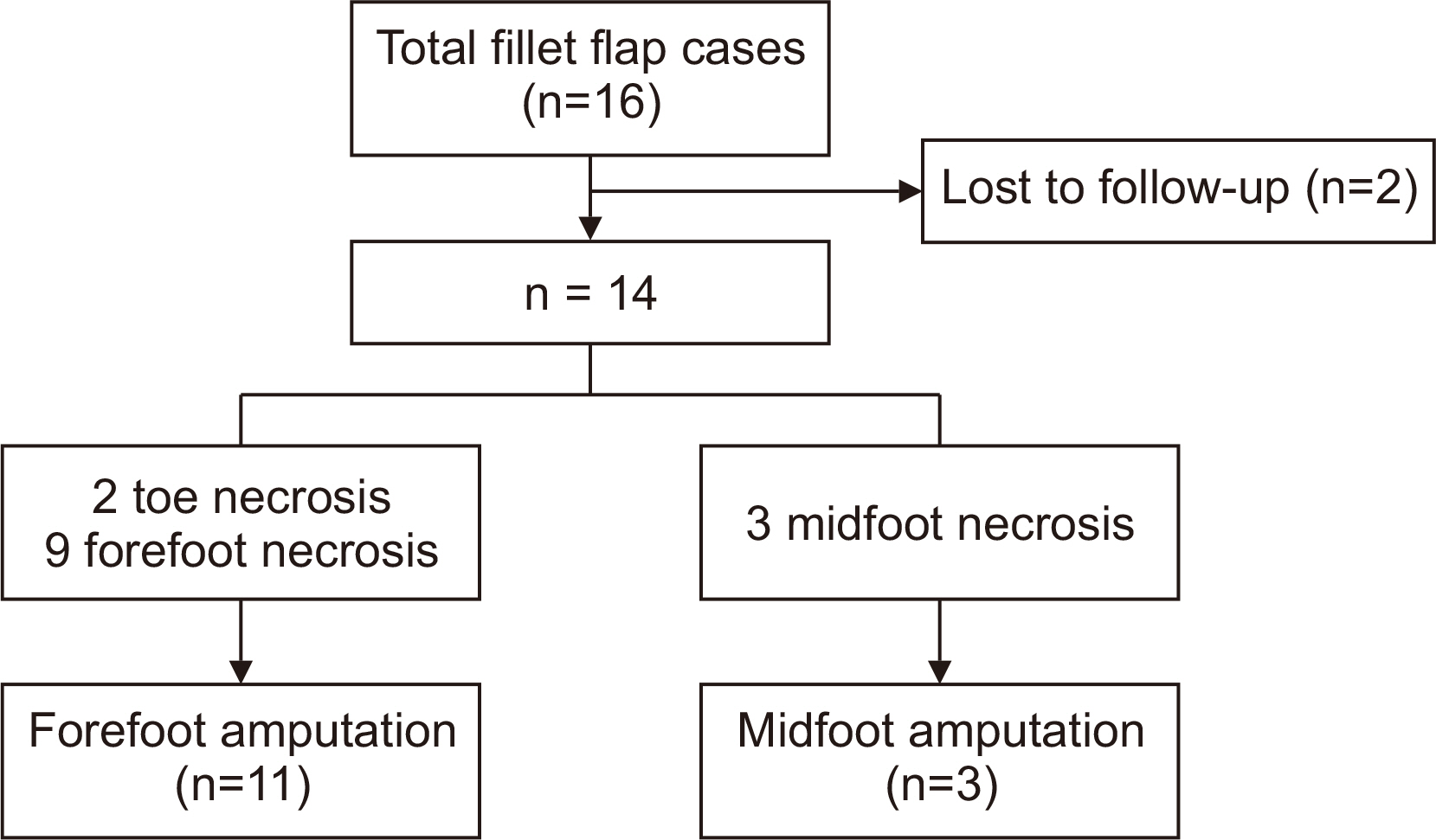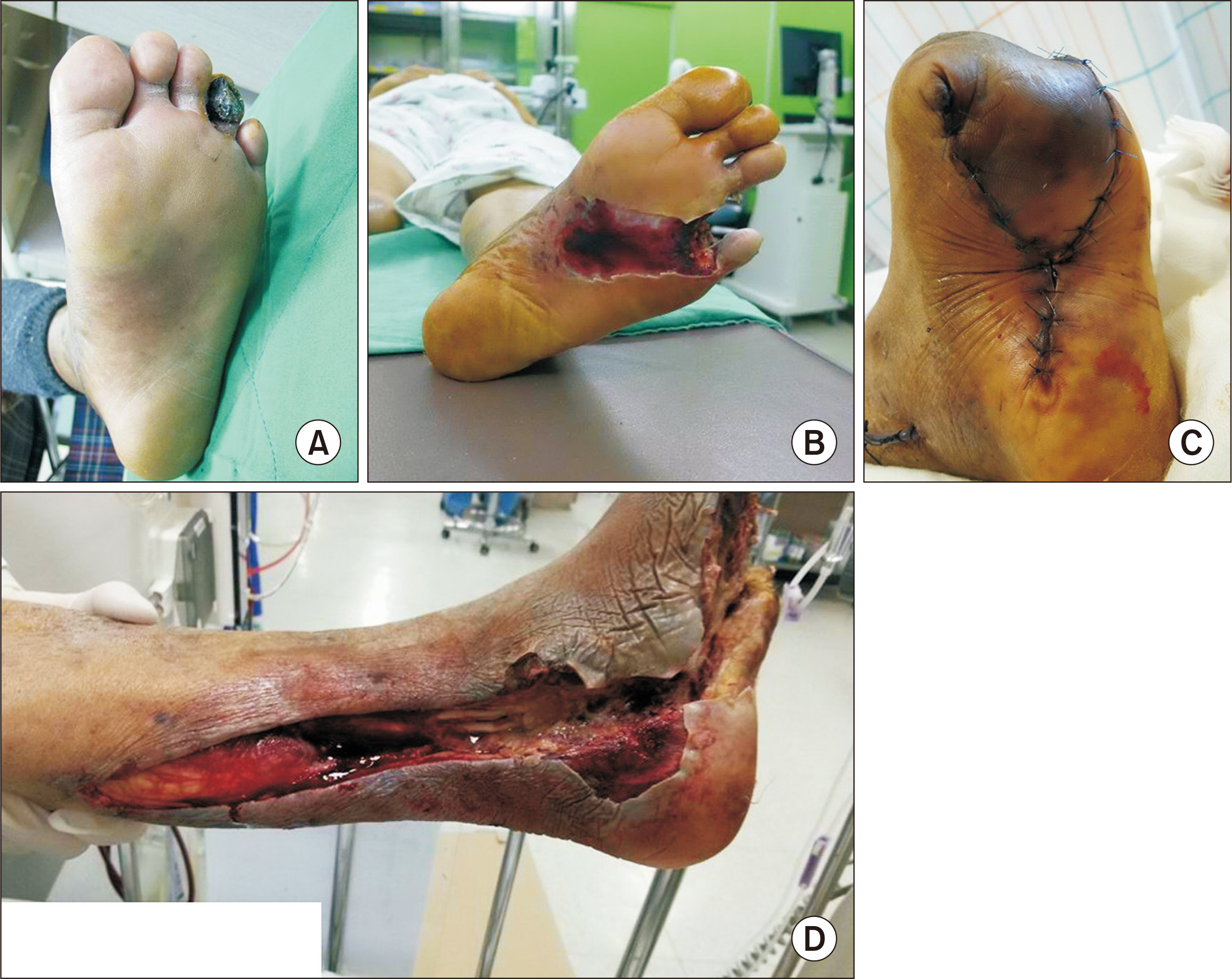J Korean Foot Ankle Soc.
2020 Dec;24(4):148-155. 10.14193/jkfas.2020.24.4.148.
Fillet Flap Coverage for Closure of Diabetic Foot Amputation
- Affiliations
-
- 1Department of Orthopedic Surgery, Hallym University Sacred Heart Hospital, College of Medicine, Hallym University, Anyang, Korea
- KMID: 2509536
- DOI: http://doi.org/10.14193/jkfas.2020.24.4.148
Abstract
- Purpose
Minor foot amputations are performed for recurrent or infected ulcers or osteomyelitis of the diabetic feet. Patients may require a large amount of bone resection for wound closure. On the other hand, this results in more foot dysfunction and a longer time to heal. The authors describe fillet flap coverage to avoid more massive resection in selected cases. This study shows the results of fillet flap coverage for the closure of diabetic foot minor amputation.
Materials and Methods
This was a retrospective case series of patients who underwent forefoot and midfoot amputation and fillet flap for osteomyelitis or nonhealing ulcers between March 2013 to November 2017. In addition, the patient comorbidities, hospital days, complications, and duration to complete healing were evaluated.
Results
Fourteen fillet flap procedures were performed on 12 patients. Of those, two had toe necrosis, nine had forefoot necrosis, and three had midfoot necrosis. Eleven forefoot amputations and three midfoot amputations were performed. Among forefoot necrosis after a fillet flap, three patients had revision surgery for partial necrosis of the flap, and two patients had an additional amputation. Two patients had additional amputations among those with midfoot necrosis. By the fillet flap, the amputation size was reduced as much as possible. The mean initial healing days, complete healing days, and hospital stay was 70.6 days, 129.0 days, and 60.0 days, respectively.
Conclusion
The fillet flap facilitates restoration of the normal foot contour and allows salvage of the metatarsal or toe.
Figure
Reference
-
1. Ogurtsova K, da Rocha Fernandes JD, Huang Y, Linnenkamp U, Guariguata L, Cho NH, et al. 2017; IDF Diabetes Atlas: global estimates for the prevalence of diabetes for 2015 and 2040. Diabetes Res Clin Pract. 128:40–50. doi: 10.1016/j.diabres.2017.03.024. DOI: 10.1016/j.diabres.2017.03.024. PMID: 28437734.
Article2. American Diabetes Association. 2018; Economic costs of diabetes in the U.S. in 2017. Diabetes Care. 41:917–28. doi: 10.2337/dci18-0007. DOI: 10.2337/dci18-0007. PMID: 29567642. PMCID: PMC5911784.3. Moxey PW, Gogalniceanu P, Hinchliffe RJ, Loftus IM, Jones KJ, Thompson MM, et al. 2011; Lower extremity amputations--a review of global variability in incidence. Diabet Med. 28:1144–53. doi: 10.1111/. DOI: 10.1111/j.1464-5491.2011.03279.x. PMID: 21388445.4. van Netten JJ, Fortington LV, Hinchliffe RJ, Hijmans JM. 2016; Early postoperative mortality after major lower limb amputation: a systematic review of population and regional based studies. Eur J Vasc Endovasc Surg. 51:248–57. doi: 10.1016/j.ejvs.2015.10.001. DOI: 10.1016/j.ejvs.2015.10.001. PMID: 26588994.
Article5. Volmer-Thole M, Lobmann R. 2016; Neuropathy and diabetic foot syndrome. Int J Mol Sci. 17:917. doi: 10.3390/ijms17060917. DOI: 10.3390/ijms17060917. PMID: 27294922. PMCID: PMC4926450.
Article6. Waters RL, Perry J, Antonelli D, Hislop H. 1976; Energy cost of walking of amputees: the influence of level of amputation. J Bone Joint Surg Am. 58:42–6. DOI: 10.2106/00004623-197658010-00007. PMID: 1249111.7. Seo SG, Yeo JH, Kim JH, Kim JB, Cho TJ, Lee DY. 2013; Negative-pressure wound therapy induces endothelial progenitor cell mobilization in diabetic patients with foot infection or skin defects. Exp Mol Med. 45:e62. doi: 10.1038/emm.2013.129. DOI: 10.1038/emm.2013.129. PMID: 24232261. PMCID: PMC3849576.
Article8. Yammine K, Assi C. 2019; A meta-analysis of the outcomes of split-thickness skin graft on diabetic leg and foot ulcers. Int J Low Extrem Wounds. 18:23–30. doi: 10.1177/1534734619832123. DOI: 10.1177/1534734619832123. PMID: 30841767.
Article9. Jeon H, Kim J, Yeo H, Jeong H, Son D, Han K. 2013; Treatment of diabetic foot ulcer using matriderm in comparison with a skin graft. Arch Plast Surg. 40:403–8. doi: 10.5999/aps.2013.40.4.403. DOI: 10.5999/aps.2013.40.4.403. PMID: 23898439. PMCID: PMC3724003.
Article10. Han HH, Lee YJ, Moon SH. 2018; Foot reconstruction using a free proximal peroneal artery perforator flap: anatomical study and clinical application. J Plast Reconstr Aesthet Surg. 71:883–8. doi: 10.1016/. DOI: 10.1016/j.bjps.2018.01.044. PMID: 29525363.
Article11. Lee Y, Lee YH, Kim MB, Park J, Baek GH. 2019; The innervated distally based first dorsal metatarsal artery flap with a wide pedicle for reconstruction of a great toe defect. Clin Orthop Surg. 11:325–31. doi: 10.4055/cios.2019.11.3.325. DOI: 10.4055/cios.2019.11.3.325. PMID: 31475054. PMCID: PMC6695326.
Article12. Hahn HM, Jeong KS, Park MC, Park DH, Lee IJ. 2017; Free-flap transfer for coverage of transmetatarsal amputation stump to preserve residual foot length. Int J Low Extrem Wounds. 16:60–5. doi: 10.1177/1534734616689508. DOI: 10.1177/1534734616689508. PMID: 28682674.
Article13. Attinger C. 1995; Soft-tissue coverage for lower-extremity trauma. Orthop Clin North Am. 26:295–334.
Article14. Emmett AJ. 1976; The filleted toe flap. Br J Plast Surg. 29:19–21. doi: 10.1016/0007-1226(76)90083-7. DOI: 10.1016/0007-1226(76)90083-7.
Article15. Küntscher MV, Erdmann D, Homann HH, Steinau HU, Levin SL, Germann G. 2001; The concept of fillet flaps: classification, indications, and analysis of their clinical value. Plast Reconstr Surg. 108:885–96. doi: 10.1097/00006534-200109150-00011. DOI: 10.1097/00006534-200109150-00011. PMID: 11547143.
Article16. Aerden D, Vanmierlo B, Denecker N, Brasseur L, Keymeulen B, Van den Brande P. 2012; Primary closure with a filleted hallux flap after transmetatarsal amputation of the big toe for osteomyelitis in the diabetic foot: a short series of four cases. Int J Low Extrem Wounds. 11:80–4. doi: 10.1177/1534734612446640. DOI: 10.1177/1534734612446640. PMID: 22561521.17. Boffeli TJ, Peterson MC. 2013; Rotational flap closure of first and fifth metatarsal head plantar ulcers: adjunctive procedure when performing first or fifth ray amputation. J Foot Ankle Surg. 52:263–70. doi: 10.1053/j.jfas.2012.10.020. DOI: 10.1053/j.jfas.2012.10.020. PMID: 23246295.
Article18. Yarmel D, Dormans JP, Pawel BR, Chang B. 2008; Recurrent pedal hobnail (Dabska-retiform) hemangioendothelioma with forefoot reconstructive surgery using a digital fillet flap. J Foot Ankle Surg. 47:48793. doi: 10.1053/j.jfas.2008.06.004. DOI: 10.1053/j.jfas.2008.06.004. PMID: 18725133.
Article19. Kalbermatten DF, Kalbermatten NT, Haug M, Schäfer D, Pierer G. 2004; Use of a combined pedicled toe fillet flap. Scand J Plast Reconstr Surg Hand Surg. 38:301–5. doi: 10.1080/02844310410027211. DOI: 10.1080/02844310410027211. PMID: 15513604.
Article20. Chung SR, Wong KL, Cheah AE. 2014; The lateral lesser toe fillet flap for diabetic foot soft tissue closure: surgical technique and case report. Diabet Foot Ankle. 5:25732. doi: 10.3402/dfa.v5.25732. DOI: 10.3402/dfa.v5.25732. PMID: 25527137. PMCID: PMC4272413.
Article21. Boffeli TJ, Thompson JC. 2014; Partial foot amputations for salvage of the diabetic lower extremity. Clin Podiatr Med Surg. 31:103–26. doi: 10.1016/j.cpm.2013.09.005. DOI: 10.1016/j.cpm.2013.09.005. PMID: 24296021.
Article22. Boffeli TJ, Waverly BJ. 2016; Medial and lateral plantar artery angiosome rotational flaps for transmetatarsal and Lisfranc amputation in patients with compromised plantar tissue. J Foot Ankle Surg. 55:351–61. doi: 10.1053/j.jfas.2014.12.007. DOI: 10.1053/j.jfas.2014.12.007. PMID: 25681945.
Article23. Wong KL, Nather A, Chanyarungrojn AP, Shen L, Ong TE, Elangovan RD, et al. 2014; Clinical outcomes of ray amputation in diabetic foot patients. Ann Acad Med Singap. 43:428–32.24. Häller TV, Kaiser P, Kaiser D, Berli MC, Uçkay I, Waibel FWA. 2020; Outcome of ray resection as definitive treatment in forefoot infection or ischemia: a cohort study. J Foot Ankle Surg. 59:27–30. doi: 10.1053/j.jfas.2019.06.003. DOI: 10.1053/j.jfas.2019.06.003. PMID: 31882144.
Article25. Lee HJ, Chin KM, Lee S, Yap HY, Ch'ng JK, Chng SP, et al. 2020; Maximally disfiguring surgery for forefoot osteomyelitis: time for a rethink? Int J Low Extrem Wounds. 19:99–104. doi: 10.1177/1534734619876841. DOI: 10.1177/1534734619876841. PMID: 31556351.
Article26. Laporta R, Atzeni M, Longo B, Santanelli di Pompeo F. 2016; Double free fillet foot flap: sole of foot and dorsalis pedis in severe bilateral lower extremity trauma, a 10-year follow-up case report. Case Reports Plast Surg Hand Surg. 3:62–5. doi: 10.1080/23320885.2016.1221730. DOI: 10.1080/23320885.2016.1221730. PMID: 27734021. PMCID: PMC5037495.
Article27. Snyder GB, Edgerton MT Jr. 1965; The principle of the island neurovascular flap in the management of ulcerated anesthetic weightbearing areas of the lower extremity. Plast Reconstr Surg. 36:518–28. doi: 10.1097/00006534-196511000-00003. DOI: 10.1097/00006534-196511000-00003. PMID: 5838551.
Article28. Lin CH, Wei FC, Chen HC. 2000; Filleted toe flap for chronic forefoot ulcer reconstruction. Ann Plast Surg. 44:412–6. doi: 10.1097/00000637-200044040-00010. DOI: 10.1097/00000637-200044040-00010. PMID: 10783098.
Article29. Morain WD. 1984; Island toe flaps in neurotrophic ulcers of the foot and ankle. Ann Plast Surg. 13:1–8. doi: 10.1097/00000637-19840700000001. DOI: 10.1097/00000637-198407000-00001. PMID: 6378037.
Article30. Brown ML, Tang W, Patel A, Baumhauer JF. 2012; Partial foot amputation in patients with diabetic foot ulcers. Foot Ankle Int. 33:707–16. doi: 10.3113/FAI.2012.0707. DOI: 10.3113/FAI.2012.0707. PMID: 22995256.
Article
- Full Text Links
- Actions
-
Cited
- CITED
-
- Close
- Share
- Similar articles
-
- Very Long Island Pedicled Sole - fillet Flap for Below - Knee Amputation Stump Reconstruction: 2 Cases Report
- A Case of Nonisland Pedicled Foot Fillet Flap for Below-Knee Amputation Stump Wound: Treatment Option for Compartment Syndrome after Fibular Free Flap Surgery
- Modified toe pulp fillet flap coverage: Better wound healing and satisfactory length preservation
- Amputation in Diabetic Foot Ulcer and Infection
- Free Fillet Flap of the Forearm Amputee for Coverage of the Contralateral below Elbow Amputee and Restoration of the Flexion of the Elbow





